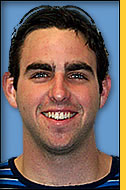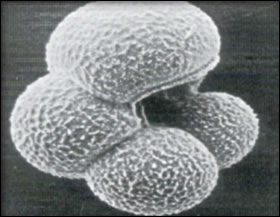 The Scientist: The Scientist:
Tomas Remenyi BSc-BcCom
Institute of Antarctic and Southern Ocean Studies, School of Maths and Physics, University of Tasmania
Armed with a double degree in Science and Commerce from Deakin University, Victoria, and with majors in analytical chemistry, economics and management, Tom moved to Tasmania in 2004 to pursue his interest in Antarctica. He is enrolled in Honours at the Institute of Antarctic and Southern Ocean Studies in Hobart.
“In Years 11 and 12 I chose subjects that interested me, because if you enjoy something you will be good at it,” says Tom. “I always enjoyed science and for a long time I was only going to do a science degree when I started uni.”
But when he got to university, Tom decided to enrol in a double degree, combining science and commerce.
“I felt there were far too many scientists in the media who had little or no knowledge of how commerce worked. If I could understand commerce, I could make my research look more appealing and exciting to the public by understanding economics and management.”
The double degree gave Tom a broader understanding of the world, as he learned to look at it through two perspectives: the scientific and the commercial. And as a bonus he earned two degrees in only four years of study.
“A combined degree effectively ‘saved’ me two years of study,” he says.
For his Honours research, Tom is now investigating the morphology of foraminifera.
“‘Forams’ are microscopic, single-celled organisms that form a shell, similar to snails, and live throughout the world’s oceans. When they die, they form fossils in deep-sea sediments and can be used in palaeoceanography, the study of ancient ocean systems, to identify how widespread sea-ice was in the past or past sea surface temperature.”
Sea-ice extent is a useful tool that helps scientists determine global palaeoclimates. A more extensive sea ice zone in the past indicates cooler conditions than present, and a smaller sea ice zone indicates warmer conditions than present.
Tom loves both the ocean and the challenge of figuring out how things work; a combination that ties in perfectly with his research project. “I love getting my hands dirty as well as having to think analytically and solve problems.” When he completes his Honours degree at the end of this year, Tom hopes to become an oceanographer and travel the world with his research.
More About the Work:
Key words:
Foramifera, sediments, paleoceanography, sea ice
Foramifera (or forams for short) are tiny single-celled organisms that have shells (also called tests). These shells can be made of material that ranges from calcium carbonate to sand grains.
Forams are found in a wide range of marine environments, from the intertidal zone to deep sea regions. After death, the numbers of foram shells that are found in sediment samples can reach tens of thousands of individuals per cubic centimeter.
The two major groups of forams are benthic which means they live in sediments on the sea floor, or planktonic which means they live in the upper waters of the oceans.

Locations of Tom's sample sites
Tom is looking for a particular type of planktonic foram called Neogloboquadrina pachyderma which is related to sea ice in Antarctica. This organism has 32 different forms (or morphotypes) depending on where it is found. So far, it has been identified from subtropical and northern Antarctic regions, Subantarctic and Antarctic regions.
While these forams might appear the same, there are a number of subtle differences. By studying the structures of the shells, Tom, after many hours of looking down the microscope, can identify features that distinguish between different morphotypes.

He is particularly interested in why different morphotypes are found in different environments, and which ones are related to sea ice.
Because different forms of forams are found in different environments, paleontolgists can use these fossils to determine environments in the past. Looking at the chemistry of the shell is particularly useful as it reflects the chemistry of the water in which it grew. Tom is measuring the amounts of 16O radio-isotopes in foram shells which provides information on the water temperature in the past. This data will help scientists understand how climate and ocean current have changes in the past – and may change in the future.

The foram, Neogloboquadrina pachyderma
Websites:
Introduction to the Foramifera
https://www.ucmp.berkeley.edu/foram/foramintro.html
Foram Facts
https://www.ucmp.berkeley.edu/fosrec/Wetmore.html
Foramifera
https://oceanworld.tamu.edu/students/forams/index.html
Foram Gallery
https://www.microscopy-uk.org.uk/mag/artmar00/forwim.html
Paleoclimatology
https://www.ngdc.noaa.gov/paleo/globalwarming/paleo.html
Institute of Antarctic and Southern Ocean Studies
https://www.antcrc.utas.edu.au/iasos
|
